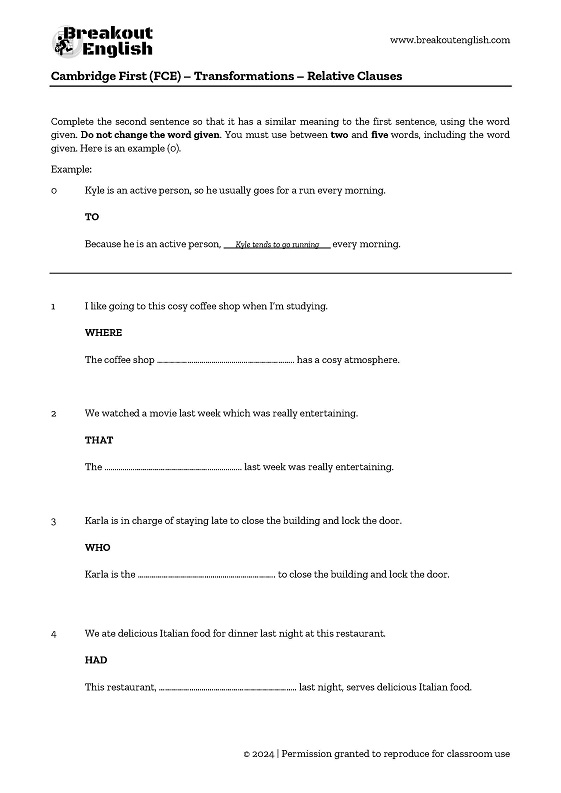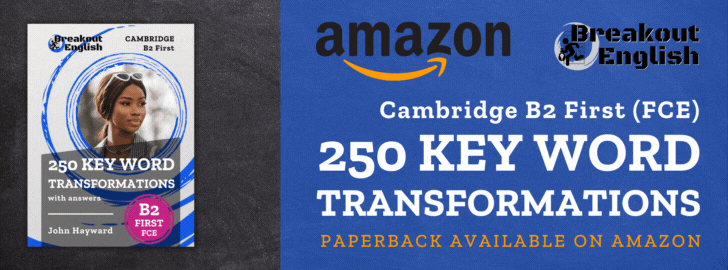When mastering the art of completing B2 First (FCE) transformations, relative clauses are essential. These clauses are not just a part of the English language; they’re a tool that can significantly enhance the clarity and sophistication of your writing and speaking. In this post, we’ll look into the different types of relative clauses, their functions, and how they can be used effectively in the FCE context. Then, we’ve got 10 First (FCE) transformations with relative clauses to test your knowledge. Whether it’s defining, non-defining, or relative clauses with prepositions, understanding these concepts is key to scoring well in the exam.
We’ve added these 10 transformations, plus loads more to our best-selling book, Cambridge B2 First (FCE) 250 Key Word Transformations. Grab a copy as a digital download or the paperback on Amazon.
GET 250 B2 FIRST (FCE) KEY WORD TRANSFORMATIONS:

Contents
Explanation of relative clauses
Relative clauses are an integral part of English, providing additional information about nouns. They are categorised into different types, each with unique features:
Defining relative clauses
These clauses are essential to the meaning of a sentence. They give essential information that defines or identifies the noun and are not separated by commas. For instance, in the sentence “The book that you lent me is excellent,” the clause ‘that you lent me‘ is a defining relative clause, specifying which book is being referred to.
We can sometimes omit the relative pronoun in a sentence, particularly when it acts as the object of the clause. This omission is more common in informal speech and writing. For example, in the sentence “The book you lent me was great,” the relative pronoun ‘that‘ is omitted after ‘book‘. We do this to avoid repetition and to make sentences sound more natural and less formal. However, it’s important to note that this is not possible with non-defining relative clauses or when the relative pronoun is the subject of the clause. Here are some more examples:
Can be omitted:
- Original: “The film that I watched was interesting.“
- With omission: “The film I watched was interesting.“
- Explanation: ‘That‘ is the object of the relative clause and can be omitted.
Cannot be omitted:
- Original: “The woman who called you is waiting.“
- With omission: “The woman called you is waiting.” (Incorrect)
- Explanation: ‘Who‘ is the subject of the relative clause and cannot be omitted.
Non-defining relative clauses
Non-defining relative clauses add supplementary information to a sentence, and this information is not essential to the overall meaning. Unlike defining relative clauses, they are separated by commas. For example, in the sentence “My sister, who lives in Spain, is a doctor,” the clause ‘who lives in Spain‘ is non-defining. It provides extra details about the sister but isn’t necessary to understand the main point of the sentence.
These clauses are particularly useful in adding depth and context to a statement without altering its meaning. They are used frequently in written English and can be a valuable tool in enhancing the descriptive quality of your language. For the FCE exam, the correct use of non-defining relative clauses demonstrates a higher level of language proficiency and control.
Remember, non-defining relative clauses always require appropriate punctuation to set them apart from the rest of the sentence.
Relative pronouns
These are used to introduce relative clauses.
- Who: Refers to people. Example: “The artist who painted this portrait is famous.“
- Which: Refers to animals and things. Example: “The car, which is red, is fast.“
- That: Can refer to both people and things. Example: “The ride that we went on was thrilling.”
- Note: ‘that‘ is only used in defining relative clauses. You will never see ‘that‘ after a comma.
- Whose: Indicates possession. Example: “The student whose book was lost was upset.”
- Note: ‘whose’ is typically followed by a noun or a noun phrase. It links the noun that follows it to the owner.
- Where: Refers to a place. Example: “The town where I grew up is small.“
- Why: Refers to a reason. Example: “The reason why she left early is unknown.“
By understanding and applying these types of clauses, you can make your English more fluent and precise, an essential skill for the FCE exam. Relative clauses are a versatile and important aspect of English grammar, especially for those preparing for exams like the FCE where you’ll find relative clauses transformations. Understanding how to use defining and non-defining clauses, along with the correct application of relative pronouns, can greatly enhance the clarity and precision of your communication. With dedication and practice, you’ll find that using relative clauses becomes more intuitive and effective in both your written and spoken English.
FCE transformations relative clauses exercises
For more practice, we’ve made a task with 10 FCE transformations using relative clauses. This worksheet includes some more basic sentences and complex sentence construction, designed to test and enhance your understanding of relative clauses in a format similar to the FCE exam.
EXAM PART: Use of English Part 4
EXAM SKILLS: Using grammar appropriate to the level (B2), key word transformations
TIME: 20 minutes + feedback
PREPARATION: One copy of the worksheet per student
Download




Dear Breakout English,
I am Claudia, a student of the English language.
I find your articles really clear and effcetive.
Thanks for sharing !
Regards,
Claudia
Thanks Claudia! I’m glad you find it useful